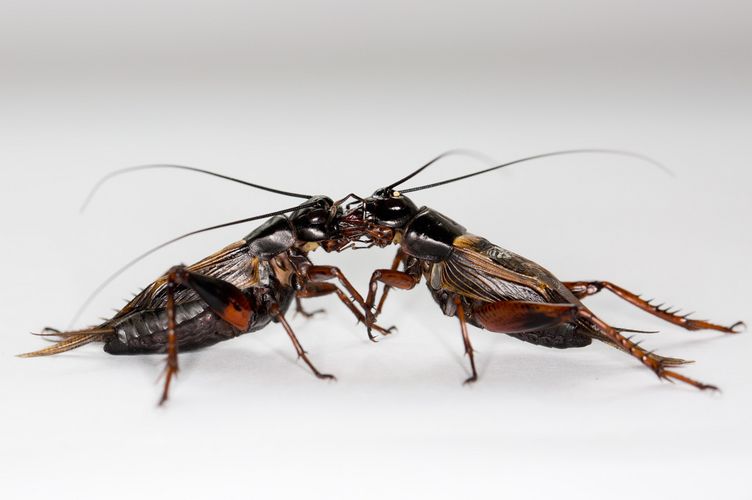Charles Darwin recognised that the struggle for existence was most severe between males of the same species. After all, they compete for the same foods, sexual partners and territory. Although there’s much to be won, fighting bears the risk of injury and losing life or limb. Hence, for aggression to be of any advantage, and even to have evolved in the first place, animals must somehow weigh up the potential costs and benefits to decide when to fight, or when it may be wiser to flee. Although much of how they do this remains a mystery, researchers from Leipzig University have lifted the secret in field crickets by manipulating brain chemicals and sensory information exchanged during fighting. Why crickets? “Well, for one,” says Paul Stevenson, who led the study with Jan Rillich, “cricket fights are spectacular and easily quantified, but more importantly their less complex brains make decisions instinctively, that is without conscious reasoning, and are accordingly easier to investigate.” They first found that positive experiences, such as possession of a valuable resource, recruit the brain chemical octopamine (the insect equivalent to noradrenaline), which increases their tendency to keep on fighting. In effect, octopamine raises their threshold to flee – or basically the amount of punishment a cricket is prepared to endure. During a fight then, crickets add up the sensory impact of their opponent’s actions (threats, bites etc.) and flee when the critical threshold is reached. This occurs due to the release of nitric oxide (NO), which gives the command. NO, in turn, recruits the messenger chemical serotonin, which causes losers to behave submissively for some time after fighting. Intriguingly, the same types of brain chemicals also influence aggression in mammals including humans, but their natural role in controlling the decision to fight or flee is still unclear. Stevenson’s team in Leipzig is currently investigating the effects of repeated, intermittent defeats, which induce depression-like symptoms in humans, mice, and apparently also crickets.
Faculties & Facilities
work Hauptgebäude Chemie
Johannisallee 29
04103 Leipzig
Phone: work +49 341 97-36000
Fax: fax +49 341 97-36094
Dean of Studies
Prof. Dr. Reinhard Denecke
Dean
Prof. Dr. Christoph Schneider
Vice-Dean
Prof. Dr. Holger Kohlmann
Deanery
Marco Weiß

- Centralised faculty body
- Chemistry Didactics
- Institute of Analytical Chemistry
- Institute of Bioanalytical Chemistry
- Institute of Chemical Technology
- Institute of Inorganic Chemistry and Crystallography
- Institute of Mineralogy, Crystallography and Materials Science
- Institute of Organic Chemistry
- Inter-institute body within the faculty
- Wilhelm Ostwald Institut of Physical and Theoretical Chemistry
work Institutsgebäude
Grimmaische Straße 12
04109 Leipzig
Phone: work +49 341 97-33500
Fax: fax +49 341 97 311 33500
Vice-Dean
Prof. Dr. Martin Friedrich Quaas
Dean
Prof. Dr. Rainer Alt
Dean of Studies
Prof. Dr. Roland Happ
Vice-Dean
Prof. Dr. Utz Dornberger
Deanery
Dr. Martina Diesener
Secretariat
Cathérine Krobitzsch

- Centralised faculty body
- Information Systems Institute
- Institute for Infrastructure and Resource Management (IIRM)
- Institute for Theoretical Economics (ITVWL)
- Institute of Accounting, Finance and Taxation (IUFB)
- Institute of Business Education and Management Training (IFW)
- Institute of Economic Policy (IWP)
- Institute of Empirical Economic Research (IEW)
- Institute of Insurance Science (IVL)
- Institute of Public Finance and Public Management (PFPM)
- Institute of Service and Relationship Management (ISRM)
- Institute of Trade and Banking (IHB)
- Institute of Urban Development and Construction Management (ISB)
work Haus 3
Marschnerstraße 31
04109 Leipzig
Phone: work +49 341 97-31400
Fax: fax +49 341 97-311 31400
Vice-Dean
Prof. Dr. Katrin Liebers
Dean
Prof. Dr. Brigitte Latzko
Vice-Dean
Prof. Dr. Conny Melzer
Dean of Studies
Prof. Dr. Jonas Flöter
Deanery
Nadja Straube

work Institutsgebäude
Schillerstraße 6
04109 Leipzig
Phone: work +49 341 97-37000
Fax: fax +49 341 97-37049
Dean of Studies
Prof. Dr. Katja Werthmann-Kirscht
Dean
Prof. Dr. Markus A. Denzel
Vice-Dean
Prof. Dr. Nadja Horsch
Dean of Studies
Prof. Dr. Holger Kockelmann
Deanery
Uta Al-Marie

- Academic body in the Faculty of History, Arts and Regional Studies
- Centralised faculty body in the Faculty of History, Arts and Regional Studies
- Department of History
- Institute for South and Central Asian Studies
- Institute for the Study of Religions
- Institute of African Studies
- Institute of Ancient Near Eastern Studies
- Institute of Anthropology
- Institute of Art Education
- Institute of Art History
- Institute of East Asian Studies
- Institute of Egyptology
- Institute of Musicology
- Institute of Oriental Studies
- Institute of Theatre Studies
work Juridicum
Burgstraße 27
04109 Leipzig
Phone: work +49 341 97-35100
Fax: fax +49 341 97-31135100
Vice-Dean
Prof. Dr. Marc Desens
Dean of Studies
Prof. Dr. Justus Meyer
Dean
Prof. Dr. Katharina Beckemper
Deanery
Dr. Christian Kraus
Secretariat
Sylvia Proksch

- Centralised faculty body
- Ernst Jaeger Institute for Corporate Restructuring and Insolvency Law
- Institut für Energie- und Regulierungsrecht
- Institut für Internationales Recht
- Institut für Recht und Politik
- Institut für Steuerrecht
- Institute for Broadcasting Law
- Institute for Environmental and Planning Law
- Institute for Foreign and European Private and Procedural Law
- Institute for German and International Law of Banking and Capital Markets
- Institute for Labour and Social Law
- Institute for Public International Law, European Law and Foreign Public Law
- Institute for the Foundations of Law
- Institute for the Legal Profession
- Professorships not bound to an institute
work Institutsgebäude
Talstraße 33
04103 Leipzig
Phone: work +49 341 97-36700
Fax: fax +49 341 97-36749
Dean
Prof. Dr. Marc Schönwiesner
Vice-Dean
Prof. Dr. Stefan Schmukle
Vice-Dean
Prof. Dr. Tilo Pompe
Dean of Studies
Prof. Dr. Immo Fritsche
Dean of Studies
Prof. Dr. Irene Coin
Deanery
Markus Lorenz

- Centralised faculty body
- Institute of Biochemistry
- Institute of Biology
- Other inter-institute body
- Wilhelm Wundt Institute for Psychology
- wissenschaftliche Einrichtung der Fakultät für Lebenswissenschaften
work Neues Augusteum
Augustusplatz 10
04109 Leipzig
Phone: work +49 341 97-32100
Fax: fax +49 341 97-32199
Dean of Studies for Computer Science
Prof. Dr. Martin Bogdan
Vice-Dean
Prof. Dr. Andreas Maletti
Dean
Prof. Dr. Bernd Kirchheim
Dean of Studies for Mathematics
Prof. Dr. Judith Brinkschulte
Deanery
Claudia Wendt


- Administration of the Faculty of Medicine
- Carl Ludwig Institute for Physiology
- Facilities of the Faculty of Medicine
- General Medicine Unit
- Independent Division for Clinical Pharmacology
- Institute of Anatomy
- Institute of Forensic Medicine
- Institute of Medical Informatics, Statistics and Epidemiology (IMISE)
- Institute of Medical Physics and Biophysics
- Institute of Pharmacy
- Karl-Sudhoff-Institute of History of Medicine and Science
- Midwifery Bachelor of Science
- Paul Flechsig Institute of Brain Research
- Research Facilities of the Faculty of Medicine
- Rudolf Boehm Institute of Pharmacology and Toxicology
- Rudolf Schönheimer Institute of Biochemistry
- Social Medicine, Occupational Health and Public Health (ISAP)
- University of Leipzig Medical Center
work Geisteswissenschaftliches Zentrum
Beethovenstraße 15
04107 Leipzig
Phone: work +49 341 97-37300
Fax: fax +49 341 97-37349
Dean of Studies
Prof. Dr. Katja Kanzler
Dean of Studies
Prof. Dr. Klaus Grübl
Vice-Dean for Research
Prof. Dr. Tinka Reichmann
Dean
Prof. Dr. Beat Siebenhaar
Dean of Studies
Prof. Dr. Eduard Werner
Dean of Studies
Jun.-Prof. Dr. Julia Fuchs
Deanery
Dr. Stephan Thomas
Secretariat
Annett Lutschin

- Centralised faculty body
- Herder-Institute (German as a Foreign Language)
- Institute for American Studies
- Institute of Applied Linguistics and Translatology
- Institute of British Studies
- Institute of Classical Studies and Comparative Literature
- Institute of German Language and Literature
- Institute of Linguistics
- Institute of Romance Studies
- Institute of Slavonic Studies
- Institute of Sorbian Studies
work Institutsgebäude
Linnéstraße 5
04103 Leipzig
Phone: work +49 341 97-32400
Dean
Prof. Dr. Marius Grundmann
Dean of Studies for Physics and Meteorology
Prof. Dr. Michael Ziese
Dean of Studies
Prof. Dr. Christoph Zielhofer
Vice-Dean for Research
Prof. Dr. Frank Cichos
Vice-Dean
Prof. Dr. Johannes Quaas
Deanery
Dr. Annett Kaldich
Secretariat
Susan Baeumler

- Centralised faculty body
- Felix Bloch Institute for Solid State Physics
- Institut für Didaktik der Physik
- Institute for Earth System Science and Remote Sensing
- Institute for Geography
- Institute for Meteorology
- Institute of Theoretical Physics
- Peter Debye Institute for Soft Matter Physics
- Serviceeinrichtungen der Fakultät für Physik und Erdsystemwissenschaften
work Geisteswissenschaftliches Zentrum
Beethovenstraße 15
04107 Leipzig
Phone: work +49 341 97-35600
Fax: fax +49 341 97-35699
Vice-Dean
Prof. Dr. Patrick Donges
Dean of Studies
Prof. Dr. Thorsten Schneider
Dean
Prof. Dr. Astrid Lorenz
Deanery
Barbara Harrmann
Secretariat
Carola Vater

work Haus 1, T-Trakt
Jahnallee 59
04109 Leipzig
Phone: work +49 341 97-31600
Vice-Dean for Research
Prof. Ph.D. Patrick Ragert
Dean of Studies
Prof. Dr. Thomas Wendeborn
Dean
Prof. Dr. Gregor Hovemann
Deanery
Marco Morgner
Secretariat
Simone Stüwe

- Abteilung Natursportarten (Ski/Kanu/Rad)
- Centralised faculty body
- Experimentelle Sporternährung
- Institute of Exercise and Public Health
- Institute of General Kinesiology and Athletics Training
- Institute of Movement and Training Science in Sports I
- Institute of Movement and Training Science in Sports II
- Institute of Sport Medicine and Prevention
- Institute of Sport Psychology and Physical Education
- Inter-institute body within the faculty
- International Trainer Course
work Institutsgebäude
Beethovenstraße 25
04107 Leipzig
Phone: work +49 341 97-35400
Fax: fax +49 341 97-35499
Vice-Dean
Prof. Dr. Roderich Andres Barth
Dean
Prof. Dr. Alexander Deeg
Dean of Studies
Prof. Dr. Jens Herzer
Deanery
Dr. Nicole Oesterreich

- Academic body in the Faculty of Theology
- Begegnungszentrum Universitätskirche
- Fakultätszentrale Einrichtungen/Theologische Fakultät
- Institut für Alttestamentliche Wissenschaft
- Institut für Kirchengeschichte
- Institut für Neutestamentliche Wissenschaft
- Institute of Practical Theology
- Institute of Religious Education
- Institute of Systematic Theology
- Teaching Unit for Classical Languages
work KVR, KFP (Lehrgebäude)
An den Tierkliniken 19
04103 Leipzig
Phone: work +49 341 97-38000
Fax: fax +49 341 97-38099
Dean
Prof. Dr. Dr. Thomas Vahlenkamp
Vice-Dean
Prof. Dr. Florian Hansmann
Dean of Studies
Prof. Dr. Katharina Luise Lohmann
Deanery
Dr. Kathy Busse
Secretariat
Ina Scherbaum

- Centralised faculty body
- Department for birds and reptiles
- Department for horses
- Department for ruminants and swine
- Department for small animal
- Institute of Anatomy, Histology and Embryology
- Institute of Animal Hygiene and Veterinary Public Health
- Institute of Animal Nutrition, Nutrition Diseases and Dietetics
- Institute of Bacteriology and Mycology
- Institute of Food Hygiene
- Institute of Immunology
- Institute of Parasitology
- Institute of Pathology
- Institute of Pharmacology, Pharmacy and Toxicology
- Institute of Physiological Chemistry
- Institute of Physiology
- Institute of Virology
- Oberholz Farm for Teaching and Research
- Serviceeinrichtungen der Fakultät




work Haus E
Liebigstraße 27
04103 Leipzig
Phone: work +49 341 97-15500
Fax: fax +49 341 97-15509

work Haus E
Liebigstraße 27
04103 Leipzig
Phone: work +49 341 97-15500
Fax: fax +49 341 97-15509

work Haus E
Liebigstraße 27
04103 Leipzig
Phone: work +49 341 97-15500
Fax: fax +49 341 97-15529

work Haus E
Liebigstraße 27
04103 Leipzig
Phone: work +49 341 97-15520
Fax: fax +49 341 97-15529

work Hauptgebäude Chemie
Johannisallee 29
04103 Leipzig
Phone: work +49 341 97-36339
Fax: fax +49 341 97-36397
Institute Head
Prof. Dr. Rebekka Heimann

work KVR,Dekanat, KFP
An den Tierkliniken 17-21
04103 Leipzig
Phone: work +49 341 97-38405
Fax: fax +49 341 97-38409

work KFP (Stallgebäude)
An den Tierkliniken 21 a
04103 Leipzig
Phone: work +49 341 97-38250
Fax: fax +49 341 97-38269
Secretariat
Claudia Baumgärtel

work KFK, Pharmakologie
An den Tierkliniken 11
04103 Leipzig
Phone: work +49 341 97-38320
Fax: fax +49 341 97-38349
Secretariat
Tina Dögl, Ines Sackersdorff

work Klinik für Kleintiere
An den Tierkliniken 23
04103 Leipzig
Phone: work +49 341 97-38700
Fax: fax +49 341 97-38799
Secretariat
Kathrin Fischer

work Geisteswissenschaftliches Zentrum
Beethovenstraße 15
04107 Leipzig
Phone: work +49 341 97-37050
Fax: fax +49 341 97-37059
Institute Head
Prof. Dr. Julia Schmidt-Funke
Secretariat
Antina Jordan

work Juridicum
Burgstraße 27
04109 Leipzig
Phone: work +49 341 97-35310
Fax: fax +49 341 97-35319

work Institutsgebäude
Linnéstraße 5
04103 Leipzig
Phone: work +49 341 97-32650
Fax: fax +49 341 97-32668
Institute Head
Prof. Dr. Jan Berend Meijer
Secretariat
Anja Heck

work Haus W
Philipp-Rosenthal-Straße 55
04103 Leipzig
Phone: work +49 341 97-15710
Fax: fax +49 341 97-15719

work Institutsgebäude
Emil-Fuchs-Straße 1
04105 Leipzig
Phone: work +49 341 97-30230
Fax: fax 9605261

work Geisteswissenschaftliches Zentrum
Beethovenstraße 15
04107 Leipzig
Phone: work +49 341 97-37505
Fax: fax 311-39204
Institute Head
Prof. Dr. Christian Fandrych
Secretariat
Ulrike Kersting

work Institutsgebäude
Grimmaische Straße 12
04109 Leipzig
Phone: work +49 341 97-33720
Fax: fax +49 341 97-33729
Institute Head
Prof. Dr. Ulrich Eisenecker



work Institutsgebäude
Burgstraße 21
04109 Leipzig
Phone: work +49 341 97-35180
Fax: fax +49 341 97-35189

work Institutsgebäude
Burgstraße 21
04109 Leipzig
Phone: work +49 341 97-35210
Fax: fax +49 341 97-35219

work Institutsgebäude
Beethovenstraße 25
04107 Leipzig
Phone: work +49 341 97-35430
Fax: fax +49 341 97-35439
Institute Head
Prof. Dr. Klaus Fitschen

work Institutsgebäude
Beethovenstraße 25
04107 Leipzig
Phone: work +49 341 97-35420
Fax: fax +49 341 97-35429
Institute Head
Prof. Dr. Jens Herzer
Secretariat
Sylvia Kolbe

work Institutsgebäude
Burgstraße 21
04109 Leipzig
Phone: work +49 341 97-35250
Fax: fax +49 341 97-35259

work Institutsgebäude
Burgstraße 21
04109 Leipzig
Phone: work +49 341 97-35270
Fax: fax +49 341 97-35279

work Geisteswissenschaftliches Zentrum
Beethovenstraße 15
04107 Leipzig
Phone: work +49 341 97-37330
Fax: fax +49 341 97-37339
Institute Head
Prof. Dr. Katja Kanzler
Secretariat
Anne Keyselt

work Institutsgebäude
Burgstraße 21
04109 Leipzig
Phone: work +49 341 97-35190
Fax: fax +49 341 97-35199

work Institutsgebäude
Talstraße 35
04103 Leipzig
Phone: work +49 341 97-32900
Fax: fax +49 341 97-32809
Institute Head
Prof. Dr. Miguel Mahecha
Secretariat
Madlen Wild

work Institutsgebäude
Burgstraße 21
04109 Leipzig
Phone: work +49 341 97-35130
Fax: fax 9731135130

work Institutsgebäude
Burgstraße 21
04109 Leipzig
Phone: work +49 341 97-35230
Fax: fax +49 341 97-31135230
Institute Head
Prof. Dr. Konrad Duden

work Institutsgebäude
Johannisallee 19a
04103 Leipzig
Phone: work +49 341 97-32790
Fax: fax +49 341 97-32799
Institute Head
Prof. Dr. Vera Denzer

work Juridicum
Burgstraße 27
04109 Leipzig
Phone: work +49 341 97-35240
Fax: fax +49 341 97-35249
Secretariat
Marion Kluge

work Institutsgebäude
Grimmaische Straße 12
04109 Leipzig
Phone: work +49 341 97-33517
Fax: fax +49 341 97-33538
Institute Head
Prof. Dr. Thomas Bruckner

work Juridicum
Burgstraße 27
04109 Leipzig
Phone: work +49 341 97-35320
Fax: fax +49 341 97-35329
Secretariat
Yvonne Apitz

work Institutsgebäude
Stephanstraße 3
04103 Leipzig
Phone: work +49 341 97-32850
Fax: fax +49 341 97-32899
Institute Head
Prof. Dr. Manfred Wendisch

work Institutsgebäude
Burgstraße 21
04109 Leipzig
Phone: work +49 341 97-35210
Fax: fax +49 341 97-35219
Secretariat
Ines Carl

work Institutsgebäude
Schillerstraße 6
04109 Leipzig
Phone: work +49 341 97-37120
Fax: fax +49 341 97-37148
Institute Head
Prof. Dr. Jowita Kramer

work Institutsgebäude
Burgstraße 21
04109 Leipzig
Phone: work +49 341 97-35350
Fax: fax +49 341 97-35359
Secretariat
Nikola Schurig

work Juridicum
Burgstraße 27
04109 Leipzig
Phone: work +49 341 97-35310
Fax: fax +49 341 97-35319
Secretariat
Andrea Kuntzsch

work Geisteswissenschaftliches Zentrum
Beethovenstraße 15
04107 Leipzig
Phone: work +49 341 97-35670
Fax: fax +49 341 97-35698
Institute Head
Prof. Dr. Dirk Quadflieg

work Institutsgebäude
Schillerstraße 6
04109 Leipzig
Phone: work +49 341 97-37160
Fax: fax +49 341 97-37169
Institute Head
Prof. Dr. Markus Dreßler
Secretariat
Steffi Rüger

work Institutsgebäude
Grimmaische Straße 12
04109 Leipzig
Phone: work +49 341 97-33540
Fax: fax +49 341 97-33549
Institute Head
Prof. Dr. Thomas Steger

work Institutsgebäude
Grimmaische Straße 12
04109 Leipzig
Phone: work +49 341 97-33690
Fax: fax +49 341 97-33699
Institute Head
Prof. Dr. Matthias Schmidt

work Geisteswissenschaftliches Zentrum
Beethovenstraße 15
04107 Leipzig
Phone: work +49 341 97-37030
Fax: fax +49 341 97-37048
Secretariat
Claudia Günther

work Hauptgebäude Chemie
Johannisallee 29
04103 Leipzig
Institute Head
Prof. Dr. Jörg Matysik
Secretariat
Uta Zeller

work Haus A
Liebigstraße 13
04103 Leipzig
Phone: work +49 341 97-22000
Fax: fax +49 341 97-22009

work Anatomie, Tierhygiene
An den Tierkliniken 41-43
04103 Leipzig
Phone: work +49 341 97-38030
Fax: fax +49 341 97-38029
Institute Head
Prof. Dr. Christoph Mülling
Secretariat
Janet Reichenbach

work Kroch-Hochhaus
Goethestraße 2
04109 Leipzig
Phone: work +49 341 97-37020
Fax: fax +49 341 97-37047
Institute Head
Prof. Dr. Michael Peter Streck

work Biochemie, TH, Lemi
An den Tierkliniken 1
04103 Leipzig
Phone: work +49 341 97-38150
Fax: fax +49 341 97-38198
Institute Head
Prof. Dr. Uwe Truyen

work Tierernährung, Mykologie
An den Tierkliniken 9
04103 Leipzig
Phone: work +49 341 97-38370
Fax: fax +49 341 97-38399

work Institutsgebäude
Schillerstraße 6
04109 Leipzig
Phone: work +49 341 97-37220
Fax: fax +49 341 97-37229
Institute Head
Dr. Stefanie Mauksch
Institute Head
Prof. Dr. Andrea Behrends
Secretariat
Annette Veit

work Geisteswissenschaftliches Zentrum
Beethovenstraße 15
04107 Leipzig
Phone: work +49 341 97-37600
Fax: fax +49 341 97-37649
Institute Head
Prof. Dr. Oliver Czulo

work Institutsgebäude
Ritterstraße 8-10
04109 Leipzig
Phone: work +49 341 97-37250
Fax: fax +49 341 97-37259
Institute Head
Prof. Andreas Wendt
Secretariat
Kerstin Rösel

work Wünschmanns Hof
Dittrichring 18-20
04109 Leipzig
Phone: work +49 341 97-35550
Fax: fax +49 341 97-35559
Institute Head
Prof. Dr. Martin Schieder

work KFK, Viro, Bakteriologie
An den Tierkliniken 29
04103 Leipzig
Phone: work +49 341 97-38180
Fax: fax +49 341 97-38199
Secretariat
Anja Ladenthin

work Institutsgebäude
Johannisallee 23
04103 Leipzig
Phone: work 36780
Fax: fax +49 341 97-36798
Institute Head
Prof. Dr. Tilo Pompe

work Institutsgebäude
Talstraße 33
04103 Leipzig
Phone: work +49 341 97-36840
Fax: fax +49 341 97-36848
Secretariat
Christina Schindler

work Geisteswissenschaftliches Zentrum
Beethovenstraße 15
04107 Leipzig
Phone: work +49 341 97-37310
Fax: fax +49 341 97-37329
Institute Head
Prof. Dr. Arne Lohmann

work Technikum Analytikum
Linnéstraße 3
04103 Leipzig
Phone: work +49 341 97-36300
Fax: fax +49 341 97-36349
Institute Head
Prof. Dr. Dirk Enke

work Geisteswissenschaftliches Zentrum
Beethovenstraße 15
04107 Leipzig
Phone: work +49 341 97-37710
Fax: fax +49 341 97-37709
Institute Head
Prof. Dr. Oliver Schelske
Secretariat
Anja Arndt


work Paulinum
Augustusplatz 10
04109 Leipzig
Phone: work +49 341 97-32250
Fax: fax +49 341 97-32252
Institute Head
Prof. Dr. Andreas Maletti
Secretariat
Karin Wenzel

work Institutsgebäude
Schillerstraße 6
04109 Leipzig
Phone: work +49 341 97-37155
Fax: fax +49 341 97-37159
Institute Head
Prof. Ph.D. Philip Clart
Secretariat
Dany Habich

work Institutsgebäude
Grimmaische Straße 12
04109 Leipzig
Phone: work +49 341 97-33560
Fax: fax +49 341 97-33569
Institute Head
Prof. Dr. Gunther Schnabl

work Haus 3
Marschnerstraße 31
04109 Leipzig
Phone: work +49 341 97-31580
Fax: fax +49 341 97-31589
Institute Head
Prof. Dr. Anne Deiglmayr

work Kroch-Hochhaus
Goethestraße 2
04109 Leipzig
Phone: work +49 341 97-37010
Fax: fax +49 341 97-37029
Institute Head
Prof. Dr. Holger Kockelmann

work Institutsgebäude
Grimmaische Straße 12
04109 Leipzig
Phone: work +49 341 97-33530
Fax: fax +49 341 97-33789
Institute Head
Prof. Dr. Bernd Süßmuth

work Haus 1, I-Trakt
Jahnallee 59
04109 Leipzig
Phone: work +49 341 97-31650
Fax: fax +49 341 97-31798
Institute Head
Prof. Dr. Petra Wagner
Secretariat
Bianka Hünemeyer

work Biochemie, TH, Lemi
An den Tierkliniken 1
04103 Leipzig
Phone: work +49 341 97-38220
Fax: fax +49 341 97-38249
Secretariat
Stephanie Schlobach

work Haus H
Johannisallee 28
04103 Leipzig
Phone: work +49 341 97-15100
Fax: fax +49 341 97-15109

work Haus 1, T-Trakt
Jahnallee 59
04109 Leipzig
Phone: work +49 341 97-31670
Fax: fax +49 341 97-31679
Institute Head
Prof. Dr. Maren Witt

work Geisteswissenschaftliches Zentrum
Beethovenstraße 15
04107 Leipzig
Phone: work +49 341 97-37350
Fax: fax +49 341 97-37359
Institute Head
Prof. Dr. Dieter Burdorf
Secretariat
Annett Kämmerer

work Biotechnologisch-Biomedizinisches Zentrum
Deutscher Platz 5
04103 Leipzig
Phone: work +49 341 97-31220
Fax: fax +49 341 97-31229
Institute Head
Prof. Dr. Gottfried Alber

work Hauptgebäude Chemie
Johannisallee 29
04103 Leipzig
Institute Head
Prof. Dr. Berthold Kersting

work Institutsgebäude
Gottschedstraße 12
04109 Leipzig
Phone: work 355305-55
Fax: fax 355305-99
Institute Head
Prof. Dr. Fred Wagner

work Geisteswissenschaftliches Zentrum
Beethovenstraße 15
04107 Leipzig
Phone: work +49 341 97-37610
Fax: fax +49 341 97-37609
Institute Head
Prof. Dr. Jochen Trommer
Secretariat
Sabine Tatzelt

work Neues Augusteum
Augustusplatz 10
04109 Leipzig
Phone: work +49 341 97-32100
Fax: fax +49 341 97-32199
Institute Head
Prof. Dr. Bernd Kirchheim

work Haus V
Härtelstraße 16-18
04107 Leipzig
Phone: work +49 341 97-16100
Fax: fax +49 341 97-16109

work Haus V
Härtelstraße 16-18
04107 Leipzig
Phone: work +49 341 97-15700
Fax: fax +49 341 97-15709


work Haus 1, T-Trakt
Jahnallee 59
04109 Leipzig
Phone: work +49 341 97-31820
Fax: fax +49 341 97-31829
Secretariat
Birgit Rother

work Haus 1, I-Trakt
Jahnallee 59
04109 Leipzig
Phone: work +49 341 97-31700
Fax: fax +49 341 97-31719

work Städtisches Kaufhaus, Aufgang E
Neumarkt 9
04109 Leipzig
Phone: work +49 341 97-30450
Fax: fax +49 341 97-30459
Institute Head
Prof. Dr. Stefan Keym
Secretariat
Katja Jehring

work Hauptgebäude Chemie
Johannisallee 29
04103 Leipzig
Phone: work +49 341 97-36550
Fax: fax +49 341 97-36599
Institute Head
Prof. Dr. Thorsten Berg
Secretariat
Katrin Hengst

work Institutsgebäude
Schillerstraße 6
04109 Leipzig
Phone: work +49 341 97-37200
Fax: fax +49 341 97-37219
Institute Head
Prof. Dr. Sebastian Maisel

work Pathologie, Parasitologie
An den Tierkliniken 35
04103 Leipzig
Phone: work +49 341 97-38080
Fax: fax +49 341 97-38095

work Pathologie, Parasitologie
An den Tierkliniken 33-37
04103 Leipzig
Phone: work +49 341 97-38270
Fax: fax +49 341 97-38299
Institute Head
Prof. Dr. Reiner Georg Ulrich
Secretariat
Gesine Kubaile-Jahn, Daniela Michel

work KFK, Pharmakologie
An den Tierkliniken 15
04103 Leipzig
Phone: work +49 341 97-38130
Fax: fax +49 341 97-38149
Institute Head
Prof. Dr. Angelika Richter
Secretariat
Annett Hoffmann

workEilenburger Str. 15a
04317 Leipzig
Phone: work +49 341 97-11901
Fax: fax +49 341 97-11813

work Geisteswissenschaftliches Zentrum
Beethovenstraße 15
04107 Leipzig
Phone: work +49 341 97-35820
Fax: fax +49 341 97-35849
Institute Head
Prof. Dr. Andrea Kern
Secretariat
Katharina Krause

work Biochemie, TH, Lemi
An den Tierkliniken 1
04103 Leipzig
Phone: work +49 341 97-38100
Secretariat
Alexandra Gück

work Veterinär-Physiologie
An den Tierkliniken 7/7a
04103 Leipzig
Phone: work +49 341 97-38060
Fax: fax +49 341 97-38097
Secretariat
Jana Kirchner

work Geisteswissenschaftliches Zentrum
Beethovenstraße 15
04107 Leipzig
Phone: work +49 341 97-35610 und -35620
Fax: fax +49 341 97-35619
Secretariat
Birgit Ruß
Office hours
Montag - Freitag 09:00 - 11:00 Uhr

work Institutsgebäude
Beethovenstraße 25
04107 Leipzig
Phone: work +49 341 97-35460
Fax: fax +49 341 97-35469
Institute Head
Prof. Dr. Alexander Deeg

work Haus 3
Marschnerstraße 31
04109 Leipzig
Phone: work +49 341 97-31490
Fax: fax +49 341 97-31498
Institute Head
Prof. Dr. Kim Lange-Schubert

work Neues Augusteum
Augustusplatz 10
04109 Leipzig
Phone: work +49 341 97-33580
Fax: fax +49 341 97-33589
Institute Head
Prof. Dr. Thomas Lenk

work Institutsgebäude
Beethovenstraße 25
04107 Leipzig
Phone: work +49 341 97-35470
Fax: fax +49 341 97-35499

work Geisteswissenschaftliches Zentrum
Beethovenstraße 15
04107 Leipzig
Phone: work +49 341 97-37410
Fax: fax +49 341 97-37429
Institute Head
Prof. Dr. Klaus Grübl
Secretariat
Angela Berge
Office hours
Montag 09:00 – 12:00 Uhr, Dienstag 14.00 – 16.00 Uhr, Freitag 09.00 – 10.00 Uhr sowie nach Vereinbarung.

work Institutsgebäude
Grimmaische Straße 12
04109 Leipzig
Phone: work +49 341 97-33750
Fax: fax +49 341 97-33759

work Geisteswissenschaftliches Zentrum
Beethovenstraße 15
04107 Leipzig
Phone: work +49 341 97-37454
Fax: fax +49 341 97-37499
Institute Head
Prof. Dr. Grit Mehlhorn
Secretariat
Claudia Twrdik, Silke Pracht

work Geisteswissenschaftliches Zentrum
Beethovenstraße 15
04107 Leipzig
Phone: work +49 341 97-35660
Fax: fax +49 341 97-35669
Institute Head
Prof. Dr. Marc Keuschnigg

work Geisteswissenschaftliches Zentrum
Beethovenstraße 15
04107 Leipzig
Phone: work +49 341 97-37650
Fax: fax +49 341 97-37659
Institute Head
Prof. Dr. Eduard Werner

work Haus 5
Marschnerstraße 29d/e
04109 Leipzig
Phone: work +49 341 97-31544
Fax: fax +49 341 97-31549
Institute Head
Prof. Dr. Saskia Schuppener
Institute Head
Prof. Dr. Conny Melzer

work INTERIM - SportMed
Rosa-Luxemburg-Straße 20-30
04103 Leipzig
Phone: work +49 341 97-31660
Fax: fax +49 341 97-31689
Secretariat
Ulla Gerlach

work Haus 1, T-Trakt
Jahnallee 59
04109 Leipzig
Phone: work +49 341 97-31630
Fax: fax +49 341 97-31639
Secretariat
Anke Bresler
Office hours
nach Vereinbarung

work Institutsgebäude
Beethovenstraße 25
04107 Leipzig
Phone: work +49 341 97-35450
Fax: fax +49 341 97-35459

work Rotes Kolleg
Ritterstraße 16-22
04109 Leipzig
Phone: work +49 341 97-30400
Fax: fax +49 341 97-30409
Institute Head
Prof. Dr. Patrick Primavesi
Secretariat
Christiane Richter

work Institutsgeb. Theor.Phys.
Brüderstraße 16
04103 Leipzig
Phone: work +49 341 97-32420
Fax: fax +49 341 97-32450

work Institutsgebäude
Grimmaische Straße 12
04109 Leipzig
Phone: work +49 341 97-33820
Fax: fax +49 341 97-33829
Institute Head
Prof. Dr. Gregor Weiß

work Institutsgebäude
Grimmaische Straße 12
04109 Leipzig
Phone: work +49 341 97-33740
Fax: fax +49 341 97-33749

work KFK, Viro, Bakteriologie
An den Tierkliniken 29
04103 Leipzig
Phone: work +49 341 97-38200
Fax: fax +49 341 97-38219

work Haus 1, T-Trakt
Jahnallee 59
04109 Leipzig
Phone: work +49 341 97-31690
Fax: fax +49 341 97-31799
Secretariat
Claudia Woog

work Haus E
Liebigstraße 27
04103 Leipzig
Phone: work +49 341 97-25601
Fax: fax +49 341 97-25609

work Verwaltungsgebäude
Rudolf-Breitscheid-Straße 38
04463 Großpösna
Phone: work +49 34297 651020
Fax: fax +49 34297 41215
Secretariat
Doris Böhmert

work Haus C
Liebigstraße 19
04103 Leipzig
Phone: work +49 341 97-25720
Fax: fax +49 341 97-25729

work Institutsgebäude
Linnéstraße 5
04103 Leipzig
Phone: work +49 341 97-32654
Fax: fax +49 341 97-32598
Institute Head
Prof. Dr. Frank Cichos
Secretariat
Andrea Kramer

work Haus V
Härtelstraße 16-18
04107 Leipzig
Phone: work +49 341 97-24600
Fax: fax +49 341 97-24609

work Haus J
Johannisallee 30
04103 Leipzig
Phone: work +49 341 97-22150
Fax: fax +49 341 97-22109

work Haus W
Philipp-Rosenthal-Straße 55
04103 Leipzig
Phone: work +49 341 97-15406
Fax: fax +49 341 97-15409

work Institutsgebäude
Beethovenstraße 25
04107 Leipzig
Phone: work +49 341 97-35494
Fax: fax +49 341 97-35498

work Wilhelm-Ostwald-Institut
Linnéstraße 2
04103 Leipzig
Phone: work +49 341 97-36500
Fax: fax +49 341 97-36399
Institute Head
Prof. Dr. Reinhard Denecke

work Städtisches Kaufhaus
Neumarkt 9
04109 Leipzig
Phone: work +49 341 97-35961
Institute Head
Prof. Dr. Jörg Jescheniak

work Institutsgebäude
Talstraße 33
04103 Leipzig

work Biotechnologisch-Biomedizinisches Zentrum
Deutscher Platz 5
04103 Leipzig
Phone: work +49 341 97-31300
Fax: fax +49 341 97-31309


work Institutsgebäude
Emil-Fuchs-Straße 1
04105 Leipzig
Phone: work +49 341 97-35850
Fax: fax +49 341 97-35859

work Institutsgebäude, ZLS wAL
Prager Straße 38-40
04317 Leipzig
Phone: work +49 341 97-30480
Fax: fax +49 341 97-30489

work Haus 1, H-Trakt
Jahnallee 59
04109 Leipzig
Phone: work +49 341 97-30320
Fax: fax +49 341 97-31749


work INTERIM-Staatsanwalts.LPZ
Straße des 17. Juni 2
04107 Leipzig
Phone: work +49 341 97-30234

work Leipzig
Phone: work +49 341 97-30082
Fax: fax +49 341 97-30045
work Leipzig
work Kroch-Hochhaus
Goethestraße 2
04109 Leipzig
Phone: work +49 341 97-30170
Fax: fax +49 341 97-30179

work Kroch-Hochhaus
Goethestraße 2
04109 Leipzig
Phone: work +49 341 97-30270
Fax: fax +49 341 97-30299

work Literatur Institut
Wächterstraße 34
04107 Leipzig
Phone: work +49 341 97-30300
Fax: fax +49 341 97-30319
Institute Head
Prof. Dr. Kerstin Preiwuß


work Städtisches Kaufhaus
Neumarkt 9
04109 Leipzig
Phone: work +49 341 97-30190
Fax: fax +49 341 97-30198

work Studienkolleg Sachsen
Lumumbastraße 4
04105 Leipzig
Phone: work +49 341 97-30240
Fax: fax +49 341 97-30259

work Flügel A und B
Philipp-Rosenthal-Straße 55
04103 Leipzig
Phone: work +49 341 97-39660
Fax: fax +49 341 97-39609

work Universitätsarchiv
Prager Straße 6
04103 Leipzig
Phone: work +49 341 97-30200
Fax: fax +49 341 97-30219

work Neues Augusteum
Augustusplatz 10
04109 Leipzig
Phone: work +49 341 97-33300
Fax: fax +49 341 97-33399

work Bibliotheca Albertina
Beethovenstraße 6
04107 Leipzig
Phone: work +49 341 97-30500
Fax: fax 31130500

